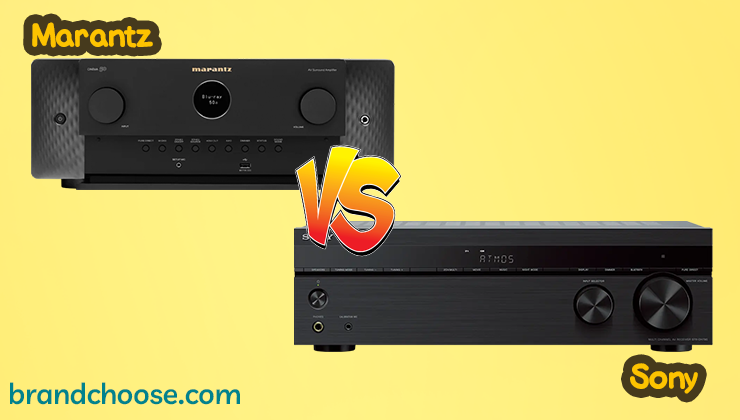Sony and Marantz are two well-known brands in the audio/video receiver market, each with its own unique strengths. Sony AV receivers are renowned for their state-of-the-art technology and features. For instance, the Sony STR-DN1080 supports Dolby Atmos and DTS:X, two of the latest surround sound formats, and also includes Sony's proprietary sound field technology, which enhances the audio experience. It also supports 4K HDR and has built-in Chromecast for easy streaming. However, some users have reported that the user interface can be somewhat complex and difficult to navigate. On the other hand, Marantz AV receivers are known for their exceptional sound quality. The Marantz SR6014, for example, supports the same Dolby Atmos and DTS:X formats as the Sony model, but also includes Auro-3D, a unique three-dimensional sound format. It also has a built-in HEOS technology for multi-room audio and supports 4K Ultra HD with Dolby Vision, HDR10, and Hybrid Log-Gamma. However, Marantz receivers are generally more expensive than their Sony counterparts, which may be a deterrent for some buyers. Both brands offer excellent performance, but the choice between them may come down to personal preference and budget.
Key Features Comparison
Product Selection
Sony and Marantz are both reputable brands in the audio/video receivers category, each offering a wide product selection to cater to different user needs. Sony's AV receivers, such as the STR-DN1080 and STR-DH590, are known for their cutting-edge technologies like Dolby Atmos, DTS:X, and Sony's proprietary S-Force PRO front surround sound technology. These technologies ensure high-quality audio output, making Sony AV receivers a preferred choice for many home theater enthusiasts. On the other hand, Marantz AV receivers, such as the SR7013 and NR1609, are renowned for their exceptional sound quality, thanks to technologies like Dolby Atmos, DTS:X, and Auro-3D. These receivers also feature HEOS wireless multi-room music streaming technology, providing a seamless listening experience across different rooms. However, Marantz receivers are generally more expensive than Sony's, which could be a deciding factor for budget-conscious consumers. Compared to other brands, both Sony and Marantz offer a competitive product selection, but the choice between the two often boils down to individual preferences for sound quality, technology, and price.
Availability
Sony and Marantz are two well-known brands in the audio/video receivers market, each with their unique availability dynamics. Sony AV receivers, such as the latest STR-DN1080, are widely available in most electronics stores and online marketplaces like Amazon, Best Buy, and the company's official website. Sony, being a global brand, has a vast distribution network, making their products accessible in many regions across the world. However, availability can sometimes be affected by high demand, especially for their latest models. On the other hand, Marantz AV receivers, such as the SR7015, are more niche products. They are ty pically found in specialized audio equipment stores and select online platforms. Marantz focuses on producing high-end, audiophile-grade equipment, which is reflected in their selective distribution strategy. While this may limit the availability of their products to a certain extent, it ensures that they maintain their brand image and cater to their target market effectively. Despite this, Marantz has been expanding their online presence, making their AV receivers more accessible to a broader audience.
Design/Look
Sony AV Receivers and Marantz AV Receivers are both renowned for their design and aesthetic appeal in the audio equipment category. Sony AV Receivers are known for their sleek and modern design, often featuring a minimalist black or silver finish and a compact form factor. The design of Sony AV Receivers is often praised for its simplicity and understated elegance, with the latest models incorporating touch-sensitive controls and OLED displays for a more sophisticated look. However, some users have noted that the minimalist design can sometimes make the interface difficult to navigate. On the other hand, Marantz AV Receivers offer a more classic and traditional look, often featuring a gold or silver finish and a larger form factor. The design of Marantz AV Receivers is often praised for its retro appeal and attention to detail, with the latest models incorporating large volume knobs and VU meters for a more vintage look. However, some users have noted that the larger form factor can make the receivers difficult to fit into smaller spaces. Compared to other brands, both Sony and Marantz AV Receivers stand out for their unique design philosophies, with Sony favouring a more modern and minimalist approach, and Marantz favouring a more classic and traditional approach.

Affordability
Most affordable brands
Sony and Marantz are two leading brands in the audio/video receivers industry, each offering a range of models with varying price points. In terms of price, Sony AV receivers are generally more affordable than their Marantz counterparts. For instance, Sony's STR-DH790, a 7.2-channel AV receiver with Dolby Atmos, comes at a price point of around $300-$400. This receiver offers 4K HDR pass-through and has a power output of 145W per channel, making it a cost-effective choice for those on a budget. On the other hand, Marantz AV receivers, while being on the higher end of the price spectrum, are known for their exceptional audio quality and advanced features. A comparable Marantz model, the NR1711, a 7.2-channel receiver with Dolby Atmos, is priced around $800-$900. This model boasts 8K/60Hz pass-through and upscaling, high-dynamic range (HDR10), Dolby Vision, Hybrid Log-Gamma (HLG), eARC, and front wide channel support on board. Although Marantz receivers are more expensive, they are often preferred by audiophiles and those who are willing to pay a premium for superior sound quality and the latest technologies. However, both brands offer good value for their respective price points, with Sony being a more budget-friendly option and Marantz offering high-end, premium receivers.
Quality/Durability
The Sony AV receiver is known for its quality and durability. It incorporates the latest technologies such as Dolby Atmos, DTS:X, and Auro-3D for an immersive sound experience. The Sony AV receiver also supports 4K HDR and HDCP 2.2 for enhanced video quality. The build quality of Sony AV receivers is solid, with a rigid frame and beam chassis that reduces pressure on the internal circuitry, thereby enhancing its durability. However, some users have reported issues with the HDMI ports and software updates, which can affect the overall durability of the product. On the other hand, the Marantz AV receiver is also a strong contender in terms of quality and durability. It is equipped with advanced technologies such as HEOS, Audyssey MultEQ, and Alexa voice control. The Marantz AV receiver supports 4K Ultra HD, HDR10, and Dolby Vision for superior video quality. The build quality of Marantz AV receivers is robust, with a copper-plated chassis that prevents interference and enhances durability. However, some users have reported issues with the network connectivity and the user interface, which can affect the overall quality and durability of the product. Compared to other brands, both Sony and Marantz have their strengths and weaknesses, but they are both reputable brands known for their quality and durability.
Reputation
Sony and Marantz are two well-established brands in the audio/video receivers market, both with strong reputations for delivering high-quality products. Sony, a Japanese multinational conglomerate, is renowned for its innovation and cutting-edge technology. Their AV receivers, such as the STR-DN1080, are known for their excellent sound quality, advanced features like 4K HDR pass-through, and Dolby Atmos support, making them a popular choice among tech-savvy consumers. However, some users have reported issues with Sony's user interface, finding it less intuitive compared to other brands. On the other hand, Marantz, a brand with a long history in high-fidelity audio equipment, is highly regarded for its focus on audio performance. Their AV receivers, like the SR7013, are praised for their superior audio quality, thanks to their HDAM (Hyper Dynamic Amplifier Module) technology and Audyssey MultEQ XT32 room calibration. Marantz receivers also support the latest audio formats, including Dolby Atmos and DTS:X. However, Marantz receivers are often more expensive than their Sony counterparts, which could be a deterrent for budget-conscious consumers. Despite this, Marantz's dedication to audio excellence has earned them a loyal following among audiophiles.
Conclusion
hen it comes to the aspect of audio and video quality, both Sony and Marantz AV receivers offer excellent performance. Sony AV receivers, such as the STR-DN1080, are equipped with the latest Dolby Atmos and DTS:X technology, which provides an immersive listening experience. They also feature 4K HDR compatibility, offering high-quality video output. On the downside, some users have reported that Sony receivers can be complex to set up and may require some technical knowledge. On the other hand, Marantz AV receivers, like the SR6014, also support Dolby Atmos, DTS:X, and Auro-3D for superior audio quality. They also offer 8K/60Hz and 4K/120Hz pass-through for the best video quality. Marantz receivers are known for their warm and detailed sound, which is appreciated by audiophiles. Compared to other brands, both Sony and Marantz stand out for their commitment to delivering high-quality audio and video performance. However, the choice between the two often comes down to personal preference and budget considerations.




















